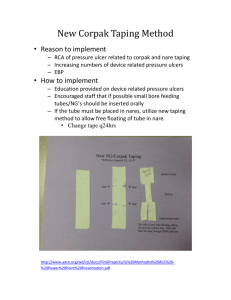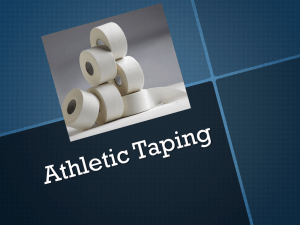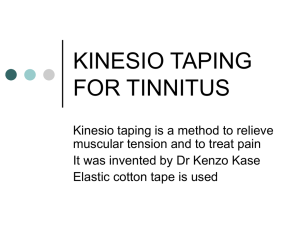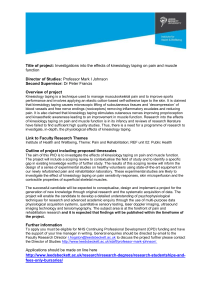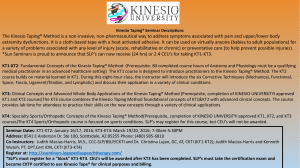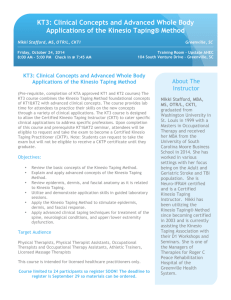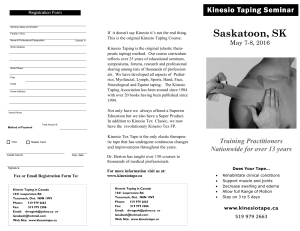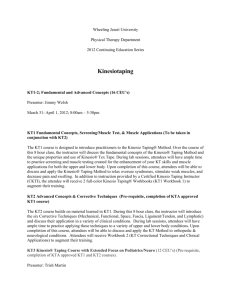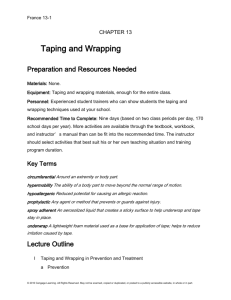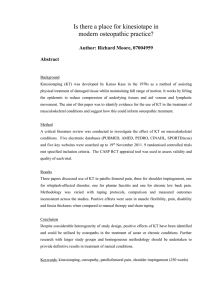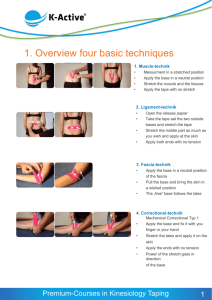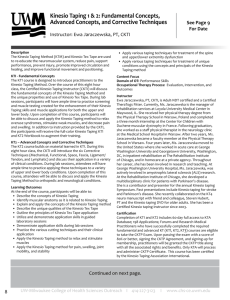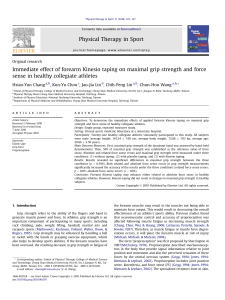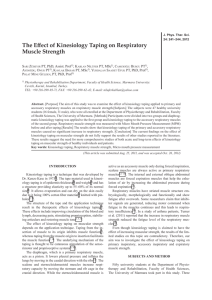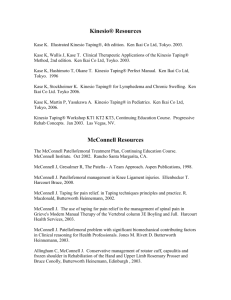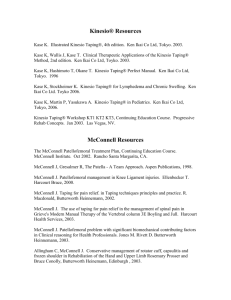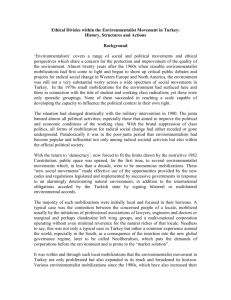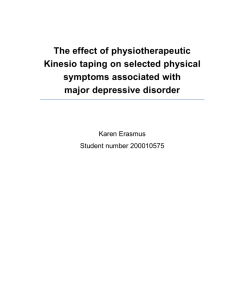Ortho Practical 2 Study Guide
advertisement
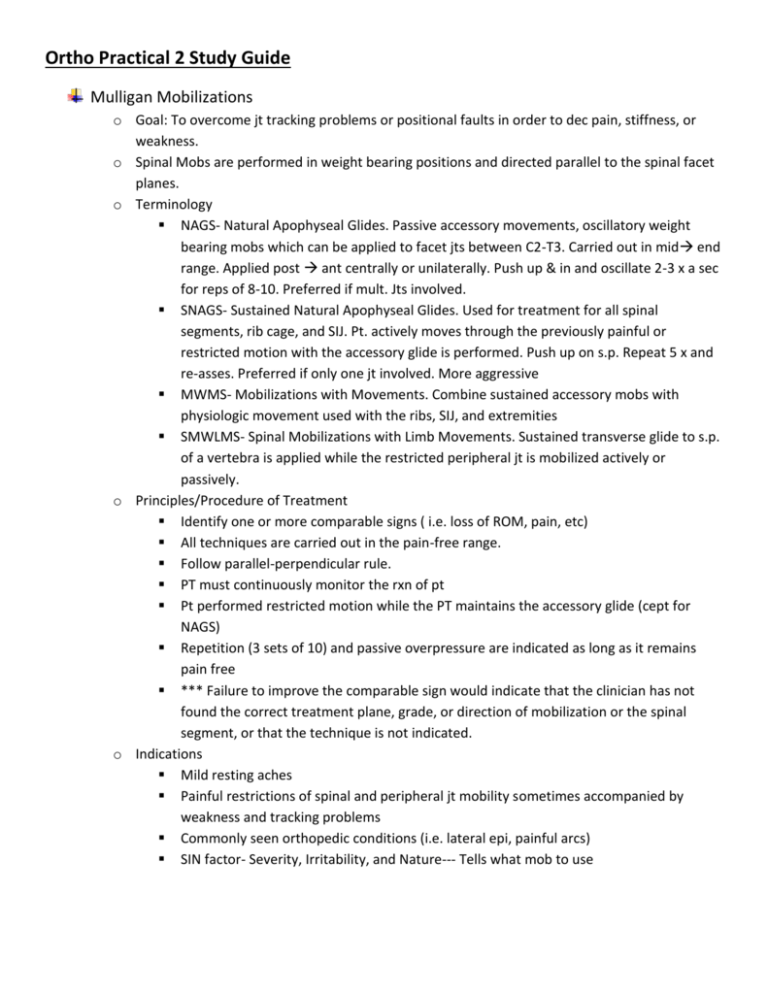
Ortho Practical 2 Study Guide Mulligan Mobilizations o Goal: To overcome jt tracking problems or positional faults in order to dec pain, stiffness, or weakness. o Spinal Mobs are performed in weight bearing positions and directed parallel to the spinal facet planes. o Terminology NAGS- Natural Apophyseal Glides. Passive accessory movements, oscillatory weight bearing mobs which can be applied to facet jts between C2-T3. Carried out in mid end range. Applied post ant centrally or unilaterally. Push up & in and oscillate 2-3 x a sec for reps of 8-10. Preferred if mult. Jts involved. SNAGS- Sustained Natural Apophyseal Glides. Used for treatment for all spinal segments, rib cage, and SIJ. Pt. actively moves through the previously painful or restricted motion with the accessory glide is performed. Push up on s.p. Repeat 5 x and re-asses. Preferred if only one jt involved. More aggressive MWMS- Mobilizations with Movements. Combine sustained accessory mobs with physiologic movement used with the ribs, SIJ, and extremities SMWLMS- Spinal Mobilizations with Limb Movements. Sustained transverse glide to s.p. of a vertebra is applied while the restricted peripheral jt is mobilized actively or passively. o Principles/Procedure of Treatment Identify one or more comparable signs ( i.e. loss of ROM, pain, etc) All techniques are carried out in the pain-free range. Follow parallel-perpendicular rule. PT must continuously monitor the rxn of pt Pt performed restricted motion while the PT maintains the accessory glide (cept for NAGS) Repetition (3 sets of 10) and passive overpressure are indicated as long as it remains pain free *** Failure to improve the comparable sign would indicate that the clinician has not found the correct treatment plane, grade, or direction of mobilization or the spinal segment, or that the technique is not indicated. o Indications Mild resting aches Painful restrictions of spinal and peripheral jt mobility sometimes accompanied by weakness and tracking problems Commonly seen orthopedic conditions (i.e. lateral epi, painful arcs) SIN factor- Severity, Irritability, and Nature--- Tells what mob to use o Contraindications Hypermobility DJD RA Osteoporosis Pregnancy Excressive Pain Infection, neoplasm, or recent fx Not effective with chronically adaptive shortened tissues or serious pathology. o Effects of Mobilizations Physiologic Effects: Induced analgesia Mechanical Effects: Inc pain-free ROM and jt mobility. Promotes proper jt tracking o Pro’s of Mulligan Pragmatic approach Focus on performance in weight bearing Combination of physiologic and accessory motion Techniques are safe and effective o Con’s of Mulligan Lacks specificity Lacks sound physiologic rationale Does not attempt to identify anatomic cause of impairment Techniques may not adhere to biomechanics of jt McConnell Taping o Used primarily for neuromuscular reeducation using a highly rigid adhesive two part taping technique. o Works on the premise that a low load applied over time results in permanent elongation of shortened structures o Common Uses [Knee/Patella] Pain Reduction Allows early return to training or sports Improve patella alignment Helpful as a protective tool Unloading of compressive forces Neuromuscular training/timing of VMO ***One limitation of studies is that they were of short duration therefore long term effects are unknown o Secondary Effects[Knee/Patella] Improvement of quadriceps strength Greater pain free recruitment of muscle fibers Earlier return to activity and training Prevention of disability/ reoccurance o Common Uses [Shoulder/Scapula] Inhibit overactive synergists and antagonists Facilitate under-active movement synergies Promote joint coordination Optimize joint alignment Reduce pain associated with movement ***There is conflicting evidence on the effectiveness of scapular taping Kinesio Taping o What is it? taping method which claims to allow jt movement without restricting the flow of blood & lymphatic fluid used to tx headaches, various sports injuries, CTS, herniated disc, poor venous circulation & neural pathologies applied over muscles to reduce pain & inflammation, relax muscles & support them during mvt on a 24hr/day basis o Features of kinesio tape 100% cotton & latex free (prevent possible allergies) ~140% elastic (same flexibility of human skin) doesn’t stretch width-wise usually applied with 10% stretch allows skin to breathe can be worn for several days (3-4 days per application) o suggestions for optimal taping results avoid extreme stretching of skin clean area to be taped- oil, sweat, & lotion free apply 1hr prior to activity, rehab, or shower rub tape to activate heat-sensitive glue avoid touching the adhesive o Application Origin to Insertion used to support acute or chronic weak muscles as muscle contracts, tape assists contraction by pulling & stimulating skin towards point of origin state: lengthened; use: muscle facilitation Insertion to Origin used for acute conditions (i.e. sprains, strains) assists in relaxation of muscles damaged due to overuse as fibers contract, tape works against the force to relax it & reduce spasm or edema “I” cut stretch skin before applying tape use: muscle relaxation used for large jt area muscle spasm, decompression, correction, small muscles, muscle groups, cross jt for stability or encourage rotation, home programs “Y cut used for large muscle groups tail reduce skin tension on corrective techniques muscle spasm, muscle support “X” cut stabilization at a jt, decompression, muscle re-education (i.e. posture taping- CTS) “Fan” reduce inflammation use base point to target direction of drainage “Buttonhole” strip used to secure I, Y, X, or Fan cut to hand or foot needed to prevent tape removal in high use arease o Method Concepts aims to give free range of motion in order to allow the body’s muscular system to heal itself bio-mechanically applying stretched tape to the skin results in convolutions which create more space b/n skin & muscles to promote flow of lymphatic fluid applying unstretched tape to stretched skin & muscles in the affected area will also form convolutions but will promote skin & muscles to contract to their normal position always best to error towards less tension o Mechanical Correction similar to conservative athletic taping used for stabilization to injured jt or muscle apply at 75% tension promotes muscle re-education in desired mechanical position o Functional Correction assists in joint mvt & ↑ proprioceptive awareness apply at 25-50% tension o Limitations body hair needs to be clipped or shaved skin integrity pt understanding & willingness to wear tape for mx days, or in public limited clinical studies o Kinesio Taping vs. White Athletic Taping white athletic taping- currently most commonly used technique in US very rigid to prevent acute injuries high latex content- skin irritation severe compression of skin & entraps moisture- skin cant breathe well can only be worn for short periods of time o Kinesio Taping vs. McConnell Taping McConnell- bracing technique ising a rigid, cotton mesh, highly adhesive tape used for neuromuscular re-education doesn’t claim to improve lymphatic flow or ↑ ROM (as kinesio taping does)

